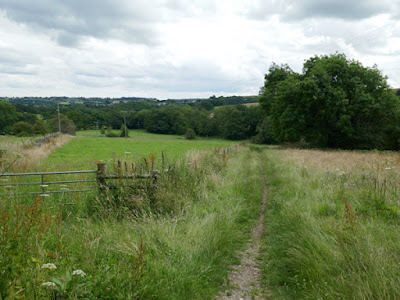 |
| An exposure of Greenmoor Rock at Akley Bank |
On other walks that I have undertaken in Sheffield, following the courses of tributary streams to the principal rivers that eventually flow to the River Don – notably Totley Brook, Limb Brook, Charlton Brook and Hartley Brook Dike – I had found numerous small rock exposures in the stream banks and streambeds but, from Blacka Moor Nature Reserve to Shorts Lane I didn’t get to see much of the various streams that I passed on this occasion and certainly no outcrops.
Descending a small escarpment of the Middle Band Rock, which forms a substantial outcrop to the north of Shorts Lane, I continued along the public footpath and over Redcar Brook, which converges with Blacka Dyke to form Old Hay Brook.
At Avenue Farm, the boundary walling is made of thinly bedded sandstone, which is very probably Greenmoor Rock that outcrops extensively to the south side of the railway line through Totley. The posts to the gate, which includes a kissing gate to prevent the passage of livestock, are made of gritstone from the Chatsworth Grit and are elaborately decorated.
Continuing to Old Hay Lane and Hillfoot Lane, I crossed over a stile that is made out of large blocks of gritstone and is set next to the garden wall of Grove House, which is constructed with more thinly bedded Greenmoor Rock with gritstone quoins.
I carried along the public footpath until I reached another stream, Needham’s Dyke, which joins Old Hay Brook just to the west of a bridge that I stopped to photograph before continuing along the path on the south side of the brook.
A little further along the brook there is a weir, which usually indicates that this formed the site of a mill, but although a small pond is marked on the 1883 Ordnance Survey (OS) map, the only works marked in the vicinity is the Totley Forge further upstream, where scythes were made.
Within a few metres of finding this weir, the rural setting suddenly becomes very suburban on Totley Brook Road, which the 1883 and 1898 editions of the OS map show before and after the Totley Tunnel was completed in 1893 - as part of the Midland Railway line that linked Sheffield to Manchester, via the Hope Valley.
Walking along the north side of Totley Brook Road, I took note of the various large detached and semi-detached late Victorian and Edwardian villas, which look like they are also built out of Greenmoor Rock, but I was completely unaware of the U-shaped brick aqueduct that carries Old Hay Brook over the railway cutting.
I was particularly interested to see the Edwardian Arts and Crafts style detached house at No. 120, which has walling made of uncoursed angular blocks of sandstone, a sweeping red plain tile roof and two large round windows with red brick dressings.
Crossing over the deep railway cutting by the pedestrian bridge, the Totley Tunnel East signal box (1893) is a rare survivor of the Victorian railway age, which is surprisingly not a listed building and its continued existence must be thrown into doubt after it closed earlier this year.
Following Grove Walk, which is well above the level of the railway track, I walked along the north side of Old Hay Brook and stopped to have a good look at the large exposure of Greenmoor Rock along Akley Bank which, looking at various old OS maps, does not appear to be a quarry.
Grove Walk continues along Akley Bank and, although I had my Estwing hammer with me, the thinly bedded Greenmoor Rock had disintegrated to the extent that a scree slope has formed beneath the exposure, which it made it difficult to gain access to the rock face.
I was able to obtain a specimen of Greenmoor Rock from one of the loose pieces and, as with several other pieces of rock that I have collected from this formation in several parts of Sheffield, it is thinly bedded and extremely fine grained, with no quartz grains discernable under a hand lens, but it has occasional very small flakes of white muscovite mica.
At the top of Grove Walk I came to Quarry Road - a cul-de-sac with C20 houses - but the 1924 OS map (revised 1920) shows that a small quarry, which opened in the latter part of the C19, still operated here; however, by the time the 1939 edition (revised 1935-1936) was published, the area had been increasingly developed with housing and is no longer marked.
Having explored a part of Sheffield that was very new to me, I finished my walk by making my way through the interwar housing estate to Baslow Road and carried on down this until I reached the Baslow Road/Grove Road bus stop, having covered a distance of 6.5 km and dropped from an elevation of 381 to 138 metres above sea level.















No comments:
Post a Comment